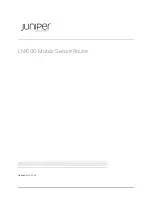
iSCSI in a Heterogeneous SAN
7
iSCSI SR2122 Storage Router: Getting Started Guide
iSCSI Initiator
The IP host, or iSCSI Initiator uses the iSCSI Driver to enable target resource recognition &
attachment to the SR2122 over IP. The iSCSI driver is configured with the Gigabit Ethernet IP
address of each SCSI routing instance running on the SR2122 with which the host is to
transport SCSI requests and responses. The iSCSI initiator sees the storage resources (LUNs)
as if they were just local drives attached directly to the server.
On the SR 2122, IP host access is controlled through an access list and optional VLAN
identifier (VID).
The iSCSI Initiator may use multiple NIC cards with teaming for failover. The term “team”
refers to the concept of multiple network adapters working together as a single network
adapter, commonly referred to as a Virtual Network Adapter.
IP Network
The IP network is the infrastructure used to transfer data between the iSCSI initiator and the
HP SR2122.
SR2122 iSCSI router
The HP SR2122 iSCSI Router is the bridge between the iSCSI Initiators and the SAN storage
that converts IP to FC protocol and provides iSCSI Initiator access to FC storage.
SCSI routing provides IP hosts with access to FC storage devices as if the storage devices were
directly attached to the hosts, with access to devices being managed primarily in the Storage
Router. An iSCSI target (also called logical target) is an arbitrary name for a group of physical
storage devices. The iSCSI targets are created and mapped to physical storage devices attached
to the Storage Router. The Storage Router presents the iSCSI targets to IP hosts (iSCSI
initiators) as if the physical storage devices were directly attached to the hosts.
With SCSI routing, storage devices are not aware of each IP host; the storage devices are
aware of the Storage Router and respond to it as if it were one FC host.
You can configure storage routers in a cluster to allow the storage routers to back each other up
in case of failure.
A storage router cluster consists of two to four storage routers connected as follows:
■
Connected to the same hosts
■
Connected to the same storage systems
■
Connected to each other through their management and high availability (HA) interfaces
In a cluster, storage routers continually exchange HA information to propagate configuration
data to each other and to detect failures in the cluster. The storage routers exchange HA
information through two separate networks: one connected to the management interface of
each Storage Router and the other connected to the HA interface of each Storage Router. To
make sure that HA information is exchanged reliably between storage routers, the storage
routers balance the transmission of HA information between the management and the HA
interfaces.
SR2122 access is controlled through an access list and a VLAN identifier (VID) number of the
hosts. An access list enables access to storage devices attached to the Storage Router with any
combination of host IP address(es), CHAP user name(s), or iSCSI name(s). An access list
contains these combinations. Host VID enables access to storage devices according to the VID
of each host. You can use a combination of access lists and VIDs to configure access in the
Storage Router; that is, you can specify that certain hosts according to IP address in a VLAN
can access storage devices attached to the Storage Router.








































